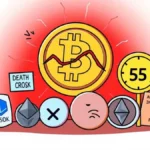Bitcoin represents the most famous digital currency because people view it as a symbol of saving their wealth through its digital format. Bitcoin has functioned as digital gold for several years because users consistently store it in cold wallets as a passive wealth retention medium. BTCFi (Bitcoin Decentralized Finance) has transformed Bitcoin through a new dynamic narrative, establishing the cryptocurrency as an active financial asset. The total value locked (TVL) of BTCFi increased from $800 million to $6.5 billion during Q4 2024, triggering institutional players’ interest. The total amount of Bitcoin that could power DeFi protocols will grow to 2.3% by 2030, according to analysts, who estimate this value to be roughly $47 billion. This surge needs analysis since BTCFi demonstrates promise as Bitcoin’s core utility. Let’s break it down.
What Is BTCFi, and Why Now?
BTCFi represents the fusion between Bitcoin and decentralized finance, where Bitcoin acts as the dominant feature of the platform. BTCFi stands apart from conventional DeFi systems because it chooses Bitcoin as its main element, while Ethereum smart contracts remain secondary. Before 2020, Bitcoin users needed to convert their BTC into wBTC and other ERC-20 tokens as a solution to access Decentralized Finance features. FCFi tokenized Bitcoin so its users could access lending services, eLD farming, and trading interfaces that the Bitcoin core platform could not support.
But the game’s changing. Bitcoin Layer 2 solutions, together with Layered Rollup Technologies, have introduced revolutionary changes to the current framework. The L2 solutions resolve Bitcoin’s notorious scalability challenges, thus enabling BTC users to execute fast and cost-effective transactions. LRTs enable Bitcoin to provide collateral throughout Ethereum and other networks while eliminating the need for subpar wrapped tokens. Bitcoin has achieved both profit-making abilities and DeFi capabilities in recent developments. The substantial increase in BTCFi’s TVL occurred during the latter part of last year because active Bitcoin usage became feasible after the technology breakthrough.
Why Bitcoin Whales Are Eyeing BTCFi in 2025
Bitcoin whales who operate as miners have kept Bitcoin sales to support their operations as a final economic strategy. Bitcoin whales have depended on CeFi loans that employ BTC assets as security instead of selling their holdings. BTCFi provides users with decentralized financial options which allow them to use their assets rather than selling them for fiat currency. Two enormous market shifts are expected to guide BTCFi towards participation in DeFi by 2025.
The launch of Bitcoin ETFs in 2025 reaches 6% of the market share of Bitcoin’s supply while reaching $100 billion in total value. Bitcoin has established itself as the crypto industry’s most secure option, thus attracting whales who want to access utility through their assets instead of selling them. In February 2025, Goldman Sachs made a $1.63 billion ETF investment, which became a major warning sign for institutions that indicate their commitment to the BTC market.
The L2 technology improvements of Bitcoin continue advancing toward full deployment, which brings improved speed alongside decreased costs to Bitcoin while maintaining its decentralized principles. The scalability and availability represent BTC’s final requirement before it could rise to DeFi prominence. The current situation enables large-scale investors to connect with DeFi protocols without compromising the base characteristics of Bitcoin because of its new access path to lending pools and staking protocols.
BTCFi’s combination of Exchange-Traded Fund legitimacy with Layer 2 efficiency ensures that bigger investors will join the platform this year.
The Hurdles to Seamless BTCFi Integration
BTCFi demonstrates remarkable promise without guaranteeing certainty. The successful establishment of DeFi platforms requires solving multiple significant technical problems.
Bitcoin’s Layer 2 solutions remain partially dependent on trust because they are not completely autonomous. Several BTC users maintain their transactions through centralized channels, which counter BTC’s well-known minimalistic approach. Research efforts continue, but purists remain unsatisfied because the proposed solutions continue to depend on intermediaries.
Many Bitcoin loyalists doubt both tokenization methods using Ethereum and cross-chain integration systems. Complete conversion of BTCFi requires native execution layers directly on Bitcoin that operate at dirt-cheap costs. An affordable, trusted L2 program may be decisive in converting Bitcoin holders into engaging users.
The growth potential of BTCFi would be jump-started as $1 trillion worth of BTC loafs into DeFi.
Bitcoin Beyond’ Digital Gold’
The simple classification of Bitcoin as ‘digital gold’ no longer fits accurately. Bitcoin transcended its role as a stashing choice when it entered the financial competition space. The institutional community, including Goldman Sachs and ETF managers, continues to enter the market as the system’s infrastructure develops quickly. Through BTCFi, users who hold Bitcoin can profit from its use in yield farming or lending, thanks to L2 technology.
Is BTCFi Bitcoin’s future? The sector shows real growth because it holds and accumulates $6.5 billion in TVL, which will expand to $47 billion by 2030. L2s achieving full trustlessness and overcoming skeptic resistance may forever remove passive characteristics from Bitcoin. The decision concerning Bitcoin’s adoption hinges more on speed than whether it will happen in 2025. Now, whales are circling around the active tech infrastructure as Bitcoin prepares to achieve new weight class status.








